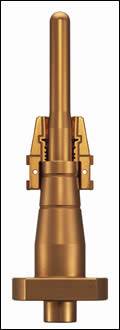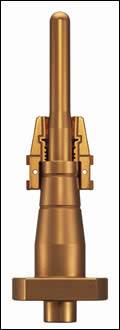Taking the Guesswork Out of Surface Treatment
Using x-ray spectrometry to help ensure superior mold performance.
Finding new ways to ensure superior mold performance is a goal most people share. The technologies that are available are impressive, and more are becoming available every day. One of the latest is x-ray spectrometry, and it can help take the guesswork out of surface treatment.
What is x-ray spectrometry? Today there are many mystery metals imported from China and other parts of the world. More and more we hear customers describe their tooling as being “like H-13”, and it can be a recipe for disaster if reality and that description don’t add up. X-ray spectrometry allows the user to determine the exact composition of any metal.
How is this possible? Simply put, all steels have a profile. Using x-ray fluorescence, the x-ray spectrometer is capable of accurately analyzing the elements that make up any known or unknown materials, in solid or liquid form. In the case of molds and dies, whether one is working with chromium, nickel, copper, molybdenum, iron, or any combination of these, an x-ray spectrometer breaks down their composition into percentages to help determine if the steel is S-7, H-13, A-2, and so on.
Under the ISO umbrella, many companies that provide coating services for production tooling are not allowed to plate unknown materials unless the customer is willing to sign off on the metal that the mold was built with first. Being able to match up the analysis with the properties of the different tool steels using x-ray spectrometry provides the information needed to allow the customer to sign off on the tooling with confidence. We now know exactly what we’re working with. It just makes sense.
Measuring Existing Plating
Equally beneficial is the fact that the thickness of any coating on any substrate can also be determined—within millionths—using x-ray spectrometry. Obviously this offers tremendous benefit when maintenance is required on an unknown substrate, but it especially comes in handy when a mold has been built and treated in one region of the country or world, but is being run and maintained in another. Unless there is some kind of certification as to the coating and application of it, the company performing plating services in the maintenance stage has a less than accurate idea of what is already on the tool.
The process is a no contact one and yet this sophisticated technology can determine the thickness of even multiple coatings on a tool without damaging the coating or the integrity of the tool itself.
As with determining metal composition, the science of x-ray fluorescence is used to accomplish measurement and composition of plating materials used. X-ray fluorescence is radiation that is emitted from the item being analyzed via an x-ray tube. Each existing element being measured gives off its own characteristic energy in the peaks of the spectrum and helps identify the coating. The intensity of the energy given off is what determines the thickness of the coating by way of a semiconductor detector or proportional counter tube. The Windows-based system then generates reports in the way of graphs and charts on a computer screen.
Because plating thicknesses may be measured to the millionths, traceable to the standards of the National Institute of Standards and Technology (NIST), this process ensures not only quality plating and polishing, but manufacturing excellence without the guesswork.
Other Uses of X-Ray Technology
The x-ray spectrometer can also be used to analyze the exact chrome and nickel composition of baths. This is done to ensure the solution is maintained with the proper chemical balance from one plating project to the next.
Using ceramic vials, the chrome and nickel are analyzed to determine the exact metal content. Since the baths are constantly being replenished as they become depleted from use, the x-ray spectrometer helps optimize the chemistry to ensure that everything is maintained in the same parameter.
Summary
The benefits of x-ray technology are many, and the moldmaking industry stands to benefit by producing high quality, certified tooling that can meet the growing demand for quality assurance and certifications. It may seem like an unnecessary extra step in the mold manufacturing and maintenance process, but when you can tell your customer with complete confidence the origin and composition of his tooling and its plating, that knowledge over the long run can save valuable time and money for the life of the tool. It’s a value added service that deserves our close attention.
Related Content
Machine Hammer Peening Automates Mold Polishing
A polishing automation solution eliminates hand work, accelerates milling operations and controls surface geometries.
Read MoreThe Ins and Outs of Hot Runner Temperature Control
A training checklist that explains the why and how of proper hot runner temperature control and system management.
Read MoreQuestions and Considerations Before Sending Your Mold Out for Service
Communication is essential for proper polishing, hot runner manifold cleaning, mold repair, laser engraving and laser welding services.
Read MoreWhat Is Scientific Maintenance? Part 1
Part one of this three-part series explains how to create a scientific maintenance plan based on a toolroom’s current data collection and usage.
Read MoreRead Next
Coatings Enhance Tool Life and Performance
Surface coatings have evolved over the past decade—offering improved operation uptime, greater consistency and higher part quality
Read MoreReasons to Use Fiber Lasers for Mold Cleaning
Fiber lasers offer a simplicity, speed, control and portability, minimizing mold cleaning risks.
Read MoreHow to Use Strategic Planning Tools, Data to Manage the Human Side of Business
Q&A with Marion Wells, MMT EAB member and founder of Human Asset Management.
Read More




















